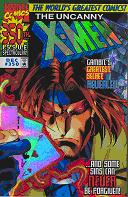
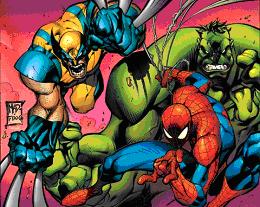
Elements of Manga #12 |
|
April 2009
As manga has increased in popularity in America, and elsewhere where English is language number-one (and please no America's number one language is really Spanish jokes) there are many illustrators, and some writers, who have taken the elements of manga and incorporated them into their storytelling style. Many of them have done this subtlety, using speed lines and some visual cues, where others have gone on to do an almost completely manga stylized story telling. (Looking at an artist like Jose Madureira (Joe Mad) as an example of incorporating many manga elements in to an art style.)
|

|
 |
|
However, incorporating some elements into comics like X-Men or Spider-Man, doesn't make them manga . . . right? Well . . . I'll sidestep that issue for a minute and instead look at what has become more common as manga has increased in popularity in the U.S. Look at the graphic novel sales for any month, even with the tough economy, and manga is heavy weight moving numbers that have all the comic book publishers a little envious. So . . . a few years ago some efforts were made by the big two, Marvel and DC, to try and tap into this "trend". First, Marvel has had many artists who have used elements of manga in their art, and they even hired Kia Asamiya, the creator of Silent Mobius and other popular manga, to draw Uncanny X-Men for awhile.
|

|
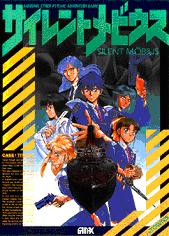 |
|
So it is no surprise that they tried to tap into the market manga by first launching the Tsunami wave (remember?) that included many manga influenced artists drawing the series (remember Sentinel or Venom?),
|

|
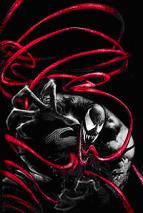 |
|
or included a very different perspective on established characters (remember Namor and Emma Frost?).
|

|
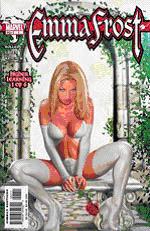 |
|
As Joe Quesada, Marvel's Editor-in-Chief put it in 2003: "Manga is not just an art style," points out Quesada. "It's also a way of storytelling. It's more character driven. But it is more visual, with more flow and bigger panels." This approach also included launching a trade paperback program that put material aimed at younger audiences (in many cases) in tokuban sized trade paperbacks (so that they would be sold next to or with the manga). DC took the other approach and just went about getting licenses to launch their own manga program, with material straight for Japan. Both programs have faded (though the tokuban reprint sized seemed to help Spider-Girl survive a bit longer, and Marvel has partnered up to do manga versions of X-Men material) or disappeared, but Tokyopop took another approach. Tokyopop, a name we've talked about a lot, decided to start cutting out some of the work and began to hire mostly unknown creators to create new material in the "manga" style. These were dubbed Original English Language Manga, according to Tokyopop and they flooded their catalogue with them and they did well . . . to begin with because it cost less and let them maintain exclusive rights to the material. The manga craze was in full bloom and Tokyopop flooded the market in order to take advantage of it with OEL manga, and other publishers tried it as well. However, they never sold quite as well as the manga from Japan and within the last year OEL Manga have begun to fade. Some, such Megatokyo (which was not started as an Original English Language Manga and was never published by Tokyopop but fits the "idea") have endured. Also the original OEL manga creators and material have endured, those published by Antarctic Press, who began doing American original material with a heavy manga creative influence long ago (more on them next time), but the push to have tons of OEL manga has faded.
|

|
 |
|
But . . . why? Well the main reason most will cite is that they weren't true "manga". Well . . . now we get back to the debate I avoided above which is actually a language debate strangely enough. According to the Japanese definition of manga, manga is any storytelling using pictures and words together. So technically . . . any comic book, superhero, French, Chinese, Korean, detective, fighting, whatever . . . would be manga. However, this definition doesn't work well in America where we invented the comic strip form (mostly . . . though we can't claim exclusive creative trade marking) which eventually evolved into creating the comic book format, which we all know. The American comic book market, and fandom, like firm definitions so they can compartmentalize the material (sad, but true, remember fan is short for fanatic). The overarching definition of manga is too broad for American fans, so manga became comic material from Japan, and more specifically done by Japanese creators (with few exceptions) in the American market. Now in trying to tap into this market, OEL manga by the traditional fan definition isn't "manga", not really, and by trying to claim the title Tokyopop got a lot of backlash from fans who wanted "real manga". One thing about American material using elements of manga before the OEL manga label came out, was that they never claimed to be manga, they were just comic books, and no one had a problem with them being that. The elements of manga have greatly permeated the American market, and they aren't going anywhere, but Original English Language Manga would be considered manga, in Japan, but just not in American to most American fans. Wakarimasu ka? (Japanese for "do you understand?") . . . Because the Elements of Manga . . . can be very confusing, especially when they jump continents.
|
| [Back to Collector Times] |
| [Prev.] | [Return to Comics] | [Disclaimer] | [Next] |
|